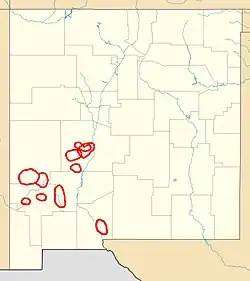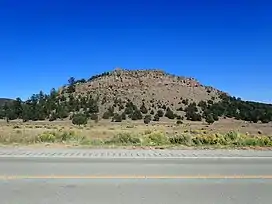Mogollon-Datil volcanic field
The Mogollon-Datil volcanic field is a large (40,000 square kilometers (15,000 sq mi))[2] silicic volcanic field in western New Mexico (Mogollon Mountains-Datil, New Mexico). It is a part of an extensive Eocene to Oligocene volcanic event which includes the San Juan volcanic field in southwestern Colorado, the Trans-Pecos volcanic field in west Texas and north central Mexico, the Boot Heel volcanic field in the bootheel of southwestern New Mexico and adjacent areas of Arizona and Mexico; and the vast volcanic field of the Sierra Madre Occidental of western Mexico.[3] The Mogollon-Datil volcanic field was formed in "four discrete pulses representing synchronized activity of two separate cauldron complexes".[4]

| Mogollon-Datil volcanic field | |
|---|---|
 Andesite-capped mesa in White House Canyon in the Mogollon-Datil volcanic field | |
| Highest point | |
| Coordinates | 33°30′N 108°00′W |
| Geography | |
| Location | New Mexico, United States |
| Geology | |
| Age of rock | Middle Tertiary[1] |
| Mountain type | Volcanic field |
Geologic history
The volcanic activity of the Mogollon-Datil began near present-day Las Cruces, New Mexico about 36.2 million years ago (mya) with the eruption of the Cueva Tuff from the Organ Caldera. Activity spread to the northwest to the Mogollon caldera by 34.0 mya, and this first pulse of activity died down around 33.5 mya. A second short pulse of activity occurred between 32.1 and 31.4 mya, with activity both in the existing southern part of the field and at a new caldera complex centered west of Socorro, New Mexico. The third and most extensive pulse of activity lasted from 29.0 to 27.4 mya. A fourth small pulse occurred from 26.1 to 24.3 mya.[4][5][6]
The caldera eruptions produced enormous volumes of tuffs across the region. The first two pulses of activity produced a total volume of 3,000 cubic kilometers (720 cu mi) of tuffs, while the third pulse produced over 6,000 cubic kilometers (1,400 cu mi) of tuffs.[7]
The silica-rich caldera eruptions were accompanied by eruptions of less silica-rich (mafic to intermediate) volcanic rock. These were mostly andesite during the first eruptive pulse, becoming less silica-rich (mostly basaltic andesite) in later eruptive pulses.[7] The third eruptive pulse was also accompanied by less explosive rhyolite eruptions of the Taylor Creek Rhyolite, which may have come from a single magma chamber less enriched in volatiles.[1]
The initial mafic to intermediate volcanism has chemical signatures typical of calc-alkaline volcanic rock of volcanic arcs. The later eruptions have been attributed to a "mini-plume" produced by the disintegration of the Farallon plate.[8]
Formations
The stratigraphic framework for the Mogollon-Datil volcanic field has undergone many revisions.[9] The Datil Formation was originally defined by Winchester in 1920 to include all the extrusive units from the field.[10] The Datil Formation was later promoted to group rank with the addition of some related sedimentary formations, such as the Baca Formation[11][12][13] and the Spears Formation.[12] The base of the group, as originally defined, rests unconformably on the Mesaverde Formation, and the series is succeeded by the Popotosa Formation of the Santa Fe Group.
The stratigraphic framework proposed by Cather, Chamberlin, and Ratte in 1994 divides the units associated with the Mogollon-Datil volcanic field into three groups and removes the Baca Formation:[9]
| Volcanic Units | Sedimentary Units | ||
|---|---|---|---|
| Mogollon Group |
tuff of Turkey Springs (24.3 Ma[14]) |
Spears Group |
South Crosby Peak Formation |
| lacuna (31.4-29.0 Ma) | |||
| Datil Group |
Tadpole Ridge Tuff (31.4 Ma[14]) | ||
Cather, Chamberlin, and Ratte find that the Alum Mountain Formation in the southern part of the field may span the lacuna between the Mogollon and Datil Groups, though they suggest a tentative assignment to the Mogollon Group. Still further south, voluminous volcanic activity in northern Chihuahua took place in this time period and no lacuna exists.[9]
Clasts of the Vicks Peak and La Jencia Tuffs have been found in the gravel beds of the Benavidez Member of the Cerro Conejo Formation in the Rio Puerco valley west of Albuquerque. These suggest that the outflow sheets of the Datil-Mogollon volcanic field reached as far north as the northern edge of the younger Mount Taylor volcanic field, where they interfingered with the Chuska Sandstone and with cherty gravels eroded off the Zuni Mountains. This outflow sheet was subsequently completely eroded away north of the Rio Salado.[15]
Notable Calderas
Northern complex
Socorro-Magdalena caldera cluster
Location: West of Socorro, South of Magdalena, and Southeast of Datil.[16]
| Name | Associated tuff[17] | Coordinates | Age |
|---|---|---|---|
| Bear Trap Caldera | tuff of Turkey Springs | 33°45′N 107°36′W[18] | 24.3 Ma |
| Mount Withington Caldera | South Canyon Tuff | 33°48′N 107°30′W[18] | 27.4 Ma |
| Hardy Ridge Caldera | Lemitar Tuff | 33°54′N 107°18′W[18] | 28 Ma |
| Sawmill Canyon Caldera | La Jencia Tuff | 34°00′N 107°18′W[18] | 28.7 Ma |
| Socorro Caldera | Hells Mesa Tuff | 34°00′N 107°06′W[18] | 32 Ma |
Southern complex
Located from Las Cruces to Mogollon:
| Name | Associated tuff | Coordinates | Age |
|---|---|---|---|
| Bursum Caldera | Bloodgood Canyon Tuff[19] | 33°30′N 108°30′W[14] | 28.0 Ma |
| Gila Cliff Dwellings Caldera | Shelley Peak Tuff[19] Davis Canyon Tuff | 33°30′N 108°15′W[14] | 28.1 Ma 29.0 Ma |
| Nogal Caldera | Vicks Peak Tuff[20] | 33°36′N 107°24′W[18] | 28.4 Ma |
| Twin Sisters Caldera | Tadpole Ridge Tuff Caballo Blanco Tuff[6] | 33°00′N 108°15′W[14] | 31.4 Ma 31.7 Ma |
| Schoolhouse Mountain Caldera | Box Canyon Tuff | 32°45′N 108°36′W[14] | 33.5 Ma |
| Mogollon Caldera (just one fragment in the Bursum Caldera wall) | Cooney Tuff Fanney Rhyolite Apache Springs Tuff[6] | 33°30′N 108°30′W[14] | 34.0 Ma |
| Emory Caldera | Kneeling Nun Tuff Fall Canyon Tuff[19] | 33°00′N 107°45′W[14] | 34.9 Ma |
| Organ Caldera |
Squaw Mountain Tuff | 32°30′N 106°45′W[14] | 35.8 Ma 35.8 Ma 36.2 Ma |
Notes
- Chapin, C.E.; Wilks, M.; McIntosh, W.C. (2004). "Space-time patterns of Late Cretaceous to present magmatism in New Mexico—comparison with Andean volcanism and potential for future volcanism" (PDF). New Mexico Bureau of Geology and Mineral Resources Bulletin. 160: 13–40. Archived (PDF) from the original on 2010-06-09. Retrieved 19 August 2021.
- Elston, W.E. (1989). "Overview of the Mogollon-Datil volcanic field". New Mexico Bureau of Mines and Mineral Resources Memoir. 46: 43.
- Baldridge, W. Scott (2004). Geology of the American Southwest. Cambridge. pp. 218–223. ISBN 978-0-521-01666-7.
- McIntosh, W. C.; Chapin, C. E.; Ratte, J. C.; Sutter, J. F. (1992). "Time-stratigraphic framework for the Eocene-Oligocene Mogollon-Datil volcanic field, southwest New Mexico". GSA Bulletin. 104 (7): 851–871. Bibcode:1992GSAB..104..851M. doi:10.1130/0016-7606(1992)104<0851:TSFFTE>2.3.CO;2.
- Chapin, Charles E.; McIntosh, William C.; Chamberlin, Richard M. (2004). "The late Eocene-Oligocene peak of Cenozoic volcanism in southwestern New Mexico". In Mack, G.H.; Giles, K.A. (eds.). The geology of New Mexico. A geologic history: New Mexico Geological Society Special Volume 11. pp. 271–290. ISBN 9781585460106.
- Rentz, Shannon P.; Michelfelder, Gary S.; Coble, Matthew A.; Salings, Emily (2018). "U-Pb zircon geochronology of calc-alkaline ash flow tuff units in the Mogollon-Datil volcanic field, southern New Mexico". In Poland, Michael P.; Garcia, Michael O.; Camp, Victor E.; Grunder, Anita (eds.). Field Volcanology: A Tribute to the Distinguished Career of Don Swanson. Geological Society of America. pp. 409–434. doi:10.1130/SPE538. ISBN 9780813725383. S2CID 214521258.
- Chapin, McIntosh & Chamberlin 2004, p. 275.
- Chapin, McIntosh & Chamberlin 2004, pp. 275–280.
- Cather, Steven M.; Chamberlin, R.M.; Ratte, J.C. (1994). "Tertiary stratigraphy and nomenclature for western New Mexico and eastern Arizona" (PDF). New Mexico Geological Society Field Conference Series. 45: 259–266. Retrieved 27 August 2020.
- Weber, Robert H (1971). "K-Ar ages of Tertiary igneous rocks in central and western New Mexico". Isochron/West. 1 (1): 33–45.
- "Tertiary and Quaternary: Baca Formation" Open File Report 94 (1977), New Mexico Bureau of Geology & Mineral Resources, page 88
- Chapin, Charles E. et al. (1978) "Exploration framework of the Socorro geothermal area, New Mexico" pp. 114–129 In Chapin, Charles E. et al. (editors) Field guide to selected cauldrons and mining districts of the Datil-Mogollon volcanic field Special Publication NO. 7, New Mexico Geological Society, OCLC 4960990
- Winchester, Dean E. (1920) Geology of Alamosa Creek Valley, Socorro County, New Mexico with special reference to the occurrence of oil and gas U.S. Geological Survey Bulletin 716-A, OCLC 6007605
- "Gila Cliff Dwellings National Monument". New Mexico Bureau of Geology & Mineral Resources. Retrieved 2010-04-29. citing from Chapin, C.E., McIntosh, W.C., and Chamberlin, R.M. (2004), "The Late Eocene—Oligocene peak of Cenozoic volcanism in southwestern New Mexico", in Mack, G.H.; Giles, K.A. (eds.), The Geology of New Mexico, a Geologic History, vol. 11, New Mexico Geological Society Special Publication, pp. 271–294
{{citation}}: CS1 maint: multiple names: authors list (link) - Koning, Daniel J.; Heizler, Mattew; Jochems, Andrew (2020). "Clues from the Santa Fe Group for Oligocene-Miocene paleogeography of the southeastern Colorado Plateau near Grants,New Mexico" (PDF). New Mexico Geoloical Society Special Publication. 14: 153–166. Retrieved 23 October 2020.
- Chamberlin, Richard M., McIntosh, William C., and Chapin, Charles E., "Oligocene calderas, mafic lavas and radiating mafic dikes of the Socorro-Magdalena magmatic system, Rio Grande rift, New Mexico: surface expression of a miniplume?"
- Chamberlin, Richard M.; McIntosh, William C.; Eggleston, Ted L. (2004). "40Ar/39Ar geochronology and eruptive history of the eastern sector of the Oligocene Socorro caldera, central Rio Grande rift, New Mexico" (PDF). New Mexico Bureau of Geology and Mineral Resources Bulletin. 160: 251–279. S2CID 130665150. Archived from the original (PDF) on 2020-02-15. Retrieved 30 August 2020.
- Chamberlin, Richard M.; Chapin, Charles E.; McIntosh, William C. (2002). Poster: Westward Migrating Ignimbrite Calderas and a Large Radiating Mafi Dike Swarm of Oligocene Age, Central Rio Grande Rift, New Mexico: Surface Expression of an Upper Mantle Diapir? (PDF). Socorro, NM: New Mexico Bureau of Geology and Mineral Resources. p. 22. Retrieved 2010-04-29.
- Ratté, J. C.; Marvin, R. F.; Naeser, C. W.; Bikerman, M. (1984). "Calderas and ash flow tuffs of the Mogollon Mountains, southwestern New Mexico". Journal of Geophysical Research. 89 (B10): 8713. Bibcode:1984JGR....89.8713R. doi:10.1029/JB089iB10p08713.
- Chamberlin, Richard M.; Cather, Steven M.; Anderson, Orin J.; Jones, Glen E. (1994). "Reconnaissance geologic map of the Quemado 30 x 60 Minute Quadrangle, Catron County, New Mexico" (PDF). New Mexico Bureau of Mines and Mineral Resources Open-file Report. 406. Retrieved 30 August 2020.
- Zimmerer, Matthew; McIntosh, William C. (2013). "Geochronologic evidence of upper-crustal in situ differentiation: Silicic magmatism at the Organ caldera complex, New Mexico". Geosphere. 9 (1): 155. doi:10.1130/GES00841.1.
Further reading
- Elston, W. E. (1976) "Glossary of stratigraphic terms of the Mogollon-Datil volcanic province" pp. 135–145 In Elston, W. E. and Northrop, S. A. Cenozoic volcanism in southwestern New Mexico: A Volume in Memory of Rodney C. Rhodes, 1943–1975 New Mexico Geological Society Special Publication No. 5, Socorro, New Mexico, OCLC 2841953